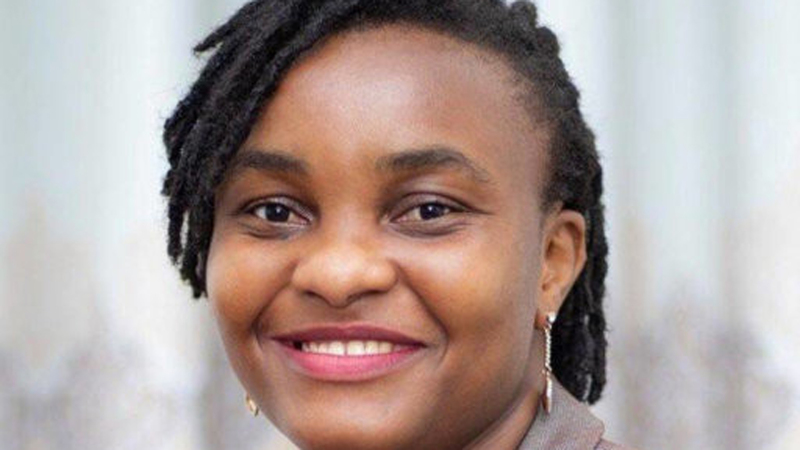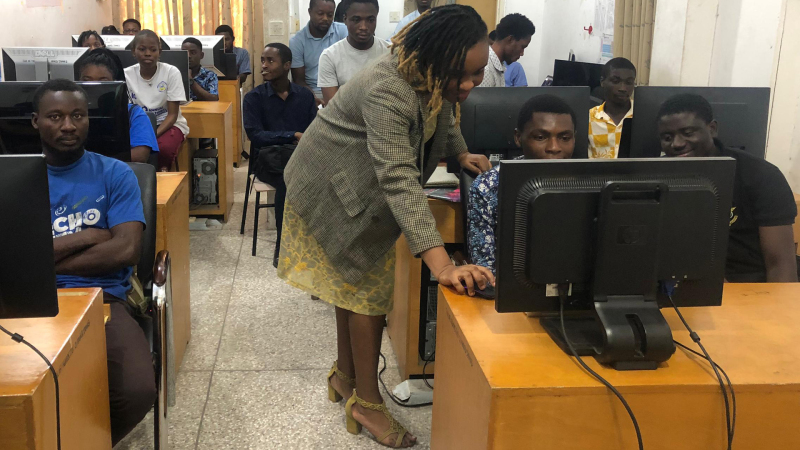Ghanaian computational chemist Caroline Kwawu and Senegalese nanomaterials physicist Balla Diop Ngom may be from different countries, but they share the same research interest: better energy-storing devices. Now, thanks to a TWAS grant, they can work together to find innovative solutions.
Through a TWAS collaborative research grant supported by Sida, they are working to turn plant waste, or ‘biomass’, into nanocellulose, a plant-derived fibre that can be used to build electrodes for energy-storage devices. The new electrodes would offer greater, longer-lasting storage over those manufactured in a factory.

The Swedish International Development Cooperation Agency (Sida) and TWAS have collaborated since 1991 to provide a flagship programme for scientists from the 66 science-and-technology-lagging countries (STLCs) identified by TWAS. There are currently four grant categories. The category for collaborative and interdisciplinary research was launched in 2022 to foster partnerships between developing world scientists who live far apart.
Under this programme, two scientists—one woman and one man—must carry out research in different fields, be previous recipients of TWAS Research Grants, either individual or group, and carry out the project in one STLC. The principal investigators must be either both from a Least Developed Country (LDC) or one from an LDC and the other from the remaining list of STLCs.
Kwawu is skilled at computer modelling and simulation—needed to predict the behaviour of new materials. Ngom is an expert in energy storage and engineering tests for nanomaterials. Their project fits well with several of the UN Sustainable Development Goals (SDGs), especially SDG 7 on clean and affordable energy, SDG 12 on responsible consumption and production, and SDG 9 on industry, innovation and infrastructure.
Containing waste
Agriculture contributes to 54% of Ghana’s Gross Domestic Product, with about 52% of the labour force engaged in agriculture, according to FAO statistics. Likewise, in Senegal, 60% of the rural population works in the agricultural sector, and in both countries the crop residues are dispersed or burnt in fields, increasing carbon dioxide emissions.
Renewable energy sources emit little to no greenhouse gases or pollutants into the air, and the use of wind and sun to produce electricity is becoming more economically viable. However, storing energy for longer periods and distributing it to local devices when most needed presents some challenges. Conventional rechargeable batteries and other new-generation storage systems are often inefficient. This is where Kwawu and Ngom's project can make a difference.

"Agricultural waste, or biomass, is a free, or at least very cheap starting material suitable for conversion into green energy," explained Caroline Kwawu of Kwame Nkrumah University of Science and Technology in Ghana. Within the TWAS-Sida collaborative project, she is in charge of carrying out the computational analyses needed to proceed with the chemical synthesis.
"Under certain experimental conditions, the cellulose of the plant residues undergoes modifications and turns into a spongy material. By mixing this new product with metals we then build new types of electrodes," she said. Electrodes are devices that conduct electricity. They are used in many energy storage devices, including car batteries and household appliances.
"The TWAS-Sida project is environmentally friendly because we do not use chemicals to convert biomass into a porous substrate, just water," said Balla Diop Ngom of University Cheikh Anta Diop in Dakar, Senegal. "In addition, the whole process takes as little as 24 hours to fabricate an electrode, starting from material that is naturally abundant and freely available such as peanut shell waste or cocoa pod husk.”
At present, Kwawu and Ngom's project is focused on obtaining prototype electrodes tailor-made for different applications. But when the process is well-refined, they will move on to looking for interested companies to scale up their product.
Impactful grants
Before obtaining the collaborative grant, both Kwawu and Ngom already received funding from TWAS. Kwawu is a recipient of a grant for individual scientists, which she used to study new materials to store energy.
"The first TWAS-Sida grant helped me build stronger research capacity, supporting the start of my career," she acknowledged, thinking of when she had neither research equipment nor access to supercomputing facilities. Today, she supervises four master's students and 15 undergraduate students, and has ongoing collaborations with UK, US, Sri Lanka, and Senegal.
"My first TWAS-Sida grant was fundamental for building my first laboratory, and opening new career perspectives," Ngom said. Today, he added, his laboratory is a point of reference in Senegal for studies about new materials for energy storage, and attracts collaborations from South Africa, US, UK, Canada, Ghana and Italy.
The vacuum filter and the consumables that he purchased through the TWAS-Sida grant now support the work of one research assistant, five postdoctoral students, five master’s students, and 11 PhD students.
Kwawu and Ngom are confident that, in the longer term, their research will also contribute to SDG 1 on eradicating poverty, and SDG 13 on climate action. Their electrodes represent a low-cost output from agricultural residues that would otherwise be discarded, and have the potential to mitigate the greenhouse gases production.
Cristina Serra

